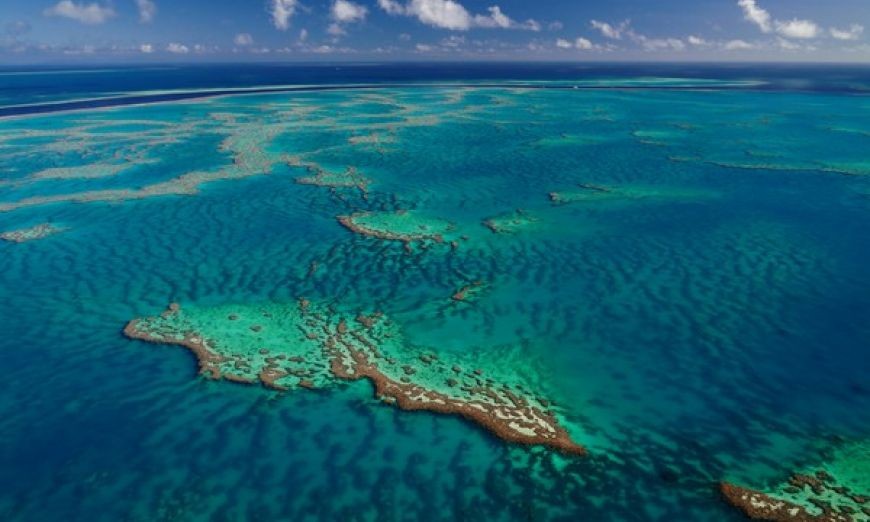Australia is blessed with beautiful and inspiring natural sites. In addition to the famous Great Barrier Reef which is the world’s largest living organism, you can see amazing sand dunes, rock formations, sprawling wilderness, stunning wildlife, and the largest sand island on earth. Here is a brief description of 10 of Australia’s natural wonders.
Great Barrier Reef
This is the largest reef system on the planet which can also be viewed from space. The Great Barrier Reef, which is a UNESCO World Heritage Site, is composed of over 2,900 separate reefs and it stretches over 3,000 kilometres off the coast of Queensland. Here, you can find 1,500 species of fish, 400 different kinds of corals and the largest variety of sea grass. It is also home to 30 species of whales, porpoises, dolphins, sharks and endangered species.
Bungle Bungles
Bungle Bungles are striped rock towers adorned with rounded orange and black sandstone layers which rise to over 570 metres above sea level. Located within the rugged terrain of the Kimberley region in northwestern Australia, Bungle Bungles has unique wildlife, caves, tropical pools, and gorges that form part of restricted Aboriginal territory.
Uluru
Uluru is a stunning red sandstone rock formation located 450km southwest of Alice Springs in the south of the Australia’s Northern Territory. This site, which is sacred to the aboriginal Anangu people, who always ask visitors not to climb the rock, is surrounded by rock caves, waterholes, springs and ancient paintings. Uluru, also called the Ayers rock has amazing hues around it at sunset and sunrise.
Pinnacles Desert
The Pinnacles Desert is one of the earth’s uncommon landscapes. Situated in Western Australia within Nambung National Park, these limestone formations are believed to have been formed from seashells which were broken down and combined with sand, and then blown inland by sea winds to create sand dunes. The park, which plays host to more than 250,000 visitors every year, is also home to emus and grey kangaroos.
Fraser Island
Fraser Island is the biggest sand island on Earth. Located just off Queensland’s coast at the tail-end of the Great Sandy Straight, this island has a length of 123 kilometres and a breadth of 22 kilometres. Believe it or not, but its beach streches for 75 miles and it’s conveniently named 75 Mile Beach. Fraser Island is a unique combination of mangrove forests, rainforests, swamps, eucalyptus woodland, and sand dunes which are as high as 240 metres above the ground level. Visitors to this island can also see an amazing assortment of wildlife including dingoes, saltwater crocodiles, flying foxes, sugar gliders, echidnas, swamp wallabies, and various species of bats.
Daintree Rainforest
Daintree is Australia’s biggest rainforest with a compelling array of pristine flora and fauna, as well as over 65 percent of the nation’s bats and butterflies. Partly protected by Daintree National Park, it is also part of the Wet Tropics heritage site in Queensland. Within this rainforest, you can find some of the earth’s oldest land plants and over 400 bird species.
Kakadu National Park
Kakadu is a large wilderness that consists of about 20,000 sq. kilometres of diverse tropical landforms and rivers. It contains floodplains, and four major rivers which make up Alligator Rivers Region. Other notable sites are the tidal flats and rocky region which are endowed with many Aboriginal rock carvings. It is home to diverse wildlife species including the saltwater crocodiles.
Twelve Apostles
The Twelve Apostles are stunning limestone stacks that you can see from the Victorian coast near the shores of Port Campbell Park. These stacks separated from the cliffs many years ago. Thereafter, they were formed in stages from caves to arches which eventually broke apart and became stacks. Their base erodes at a measurable rate of about two centimetres per year.
Shark Bay
Located about 800 kilometres to the north of Australia’s westernmost tip is the Shark Bay – a place of amazing natural beauty. Dramatic cliffs, white sand dunes, and rocky limestone make up the nearly 1500-kilometre bay area. This World Heritage Site now contains nearly 13 percent of the world’s population of sea cows, about 10,000 dudongs, as well as various species of fish, dolphins, reptiles, birds and many threatened Australian mammals.
Katherine Gorge
The Katherine Gorge in located in the Northern Territory and it consists of 13 gorges which can be navigated over about 62 miles on walking trails. The Katherine Gorge is part of the Nitmiluk National Park and it runs along the course of the calm Katherine river which has a large population of freshwater crocodiles.

